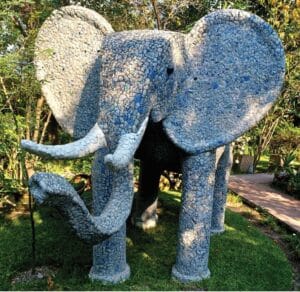
Why you should visit Guanajuato: A rich Mexican city, often dismissed by travelers
Story and Photos by Irene Middleman Thomas
The singing was getting louder, so I dashed over to my streetside hotel room window and gazed between the wrought iron bars onto the moonlit cobblestone street. Sure enough, one of the renowned callejoneadas — this one, for a wedding — was passing.
Every night in Guanajuato, troubadours lead the way through this colonial Mexican city’s narrow lanes, tunnels and alleyways. A few nights later, my friend and I joined a multinational, somewhat tipsy group, singing along (as best as we could) to De Colores as we strolled after the musicians, typically University of Guanajuato students, adorned in medieval-looking Spanish velvet breeches and finery.
Guanajuato’s 16th-century Spanish Colonial Baroque architecture, unique customs and history as a leading 18th-century silver mining center have earned it a spot on the UNESCO world heritage list, maintained by the United Nations Educational, Scientific and Cultural Organization. The city center is adorned with small plazas and colonial-era mansions, churches and other buildings made of colorful sandstone.
Yet throngs of tourists visit (and move to) nearby San Miguel de Allende, somehow dismissing this gem just 90 minutes away.
Why Guanajuato? It feels like what San Miguel once was. I heard much more Spanish than English. That’s not always the case in San Miguel, which can feel like an outpost of the U.S. due to expats and tourists.
We found many delightful small boutique hotels (although there are several large ones as well), along with sidewalk cafes and restaurants beckoning us in from narrow alleyways.

It’s a walking city: Guanajuato is renowned for its subterranean passageways and tunnels, built in the late 1800s to combat flooding. Some streets are fully or partially underground, and touring the tunnels can be an adventure. Above ground, the city sits in a narrow valley, and many of its skinny, winding streets are too narrow for cars to pass each other. Some streets are formed out of seemingly infinite sets of stairs up the steep hillsides.
Tourist attractions: Most are worth visiting, such as the San Cayetano Church, an 18th-century masterpiece built with the riches of the area’s silver mines. A selfie must-do — if you have a partner — is at the famed skinny-skinny Alley of the Kiss (Callejón del Beso), where couples must lean in from opposite balconies. The Mummy Museum displays dozens of conserved naturally mummified bodies found in Guanajuato’s cemetery many decades ago.

The culture: Visitors flock here in October for the annual Festival Internacional Cervantino, a cultural mix of opera, theater, film, art exhibitions, talks, concerts and dance recitals in 70 venues. Don’t miss the exquisite Teatro Juarez, recently refurbished to even greater glory. Built from 1872 to 1903 in Neoclassical style, its façade contains nine sculptures depicting the Muses of Greek mythology.
The muralist Diego Rivera was born in Guanajuato and spent his early years there. His home is now a small but worthwhile museum with a large collection of paintings, about 100 of which are Rivera’s early and little-known works.
City life: Strolling down the twisting lanes, we enjoyed a city alive — a rooftop flowerpot with tumbling vines; cats peering from tiny windows; doorways draped in traditional archway decorations; galleries; boutiques; and bistros. On a sunny afternoon, we relaxed on one of the many wrought iron benches in a small park. We smiled as a proud dad held his toddling youngster’s hand as he chased a cooing pigeon. Vendors with enormous bunches of colorful balloons and ice cream carts with artisanal flavors (avocado, corn, Mexican vanilla) enticed us with their wares.
Excursions: The small town of Tarandacuao, less than three hours away, is known for its unique, intricate style of ceramics. The famed studio of Javier Servin hosts several charming casitas set among lush gardens featuring life-sized animals decorated with mosaic ceramic pieces. I fell in love with my casita, meticulously and lovingly decorated with whimsical folkloric art and antiques.
The region boasts many thermal water and hot spring spots, especially between nearby San Miguel de Allende and Dolores Hidalgo, stemming from subterranean volcanic activity. Kayaking, birdwatching, volcanic-crater touring, zip lining, ATVriding and extreme (and not-so-extreme) hiking in the surrounding canyons and mountains are welcome respites from the bustle of city life.
THE DETAILS
What to wear: This charming town’s streets are almost all cobblestone, so flats and sneakers are de rigueur.
What to eat: Be sure to enjoy artisanal ice cream cones from the carts of La Garrafa Nieves, including the one in front of the magnificent yellow-orange basilica. My favorite flavor? Mazapán.
Be a tourist: Join a callejoneada, at least once.
Souvenirs: It’s kind of creepy, and sure to raise eyebrows, but buy a cellophane-wrapped “mummy” lollipop, or charamusca, in one of the Mexican regional candy stores or in the Hidalgo market.
Irene Middleman Thomas is a North Texas journalist and contributor to 360West
